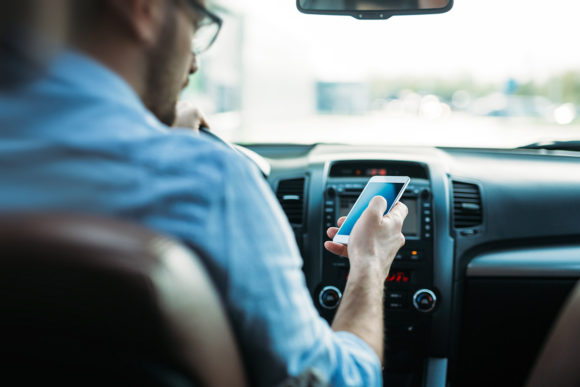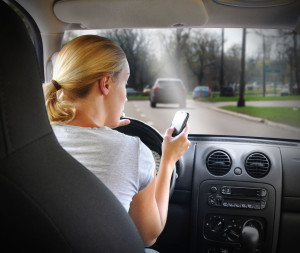In 2021, distracted driving killed 3,522 people.
April is Distracted Driving Awareness Month, and statistics show that distracted driving has become an increasingly common and fatal hazard.
According to the National Highway Traffic Safety Administration (NHTSA), in 2020, 8% of fatal crashes, 14% of injury crashes, and 13% of all police-reported motor vehicle traffic crashes were reported as distraction-affected crashes. That year, distracted driving also killed 587 nonoccupants, including pedestrians, pedal cyclists and others.
The 2023 Travelers Risk Index on distracted driving found that 70% of survey respondents said that distracted driving is a bigger problem now than it was a few years ago. About 34% of drivers say they’ve had a near-miss crash because of their distracted driving.
The Traveler’s Risk Index also cites NHTSA’s 2019 figures showing the total economic impact of distracted driving far exceeds the cost of speeding and alcohol-impaired driving.
While cell phone use – whether calling, texting, using the internet, posting to social media, or even taking videos — is the most common cause of distracted driving, the survey also found that drowsiness, heightened emotions and work-related stress were often cited as distractions by drivers. Other risky activities included adjusting the radio or GPS, distractions caused by passengers, applying makeup, eating and drinking.
Distracted driving and fatalities
Distracted driving is a leading contributor to road deaths and injuries in the United States and many other countries worldwide, playing a role in 25% to 30% of fatal crashes.
According to the NHTSA, in 2020, there were 3,142 deaths and an estimated 324,652 injured on U.S. roadways because of distracted driving. However, numbers cited in distracted driving accidents and fatalities may underrepresent the problem, according to the National Distracted Driving Coalition (NDDC). Collecting accurate data is complicated as much relies on self-reporting from drivers or crash data sources. First responders at the scene of an accident may have difficulty identifying distraction as the cause of an accident because drivers and passengers may not admit to distracted driving or because there are no surviving witnesses to the accident.
When it comes to distracted driving, most people surveyed in the 2023 Travelers Risk Index can recognize and agree on the dangers – but they’ll still admit to being distracted behind the wheel.
Among those surveyed, electronic devices were among the leading causes of distraction. About 79% of drivers admitted to making or receiving calls, about 56% of drivers admitted to reading a text message or email, and 74% admitted to looking at map directions on a smartphone, over a quarter of drivers admitted to posting social media updates (28%) or taking photos or videos while on the road (27%).
Is all this distraction perceived as a problem among drivers? In the NDDC report Distracted Driving Prevalence Data: Sources, Challenges & Technological Solutions report from December 2022, 67% of those who responded were concerned about hand-held phone use between 2016 and 2021, whereas more than 80% of respondents reported concern about texting and driving.
Working on the road
Travelers’ survey revealed that 32% of business leaders are concerned about their employees using technology while driving for work purposes, up from 26% last year. And those concerns are founded – 31% of employees admit to getting into a crash or collision while driving for work because they’re distracted, up from 26% last year. Additionally, 37% of workers surveyed said they had taken work-related calls, texts, or emails while driving. When asked why, 44% said it might be a work-related emergency, and 43% responded that they felt the need always to be available.
More than 30% of executives reported that their employees had been involved in crashes while driving for business because they were distracted by their mobile devices.
Non-tech distractions
The Travelers Index also showed that emotional distraction, drowsiness and work-related stress play significant roles in unsafe driving behaviors. More than 75% of drivers said that they had experienced stress or intense emotions while behind the wheel, and 62% said that they had driven while drowsy.
The latest information in the index indicates that driving after 20+ hours without sleep is comparable to driving with a blood-alcohol concentration of 0.08%, and a driver is three times more likely to crash when fatigued.
Keeping eyes on the road
According to the NHTSA, the most dangerous driving activities, including texting, combine visual, manual and cognitive distractions. While talking on a phone may be primarily a cognitive and emotional distraction, texting, emailing and other activities that involve a more visual distraction are considered riskier.
One of the most significant driving safety issues is what is described as “the half-minute distraction hangover.” Once a driver has been distracted, research shows it can take up to 27 seconds to refocus on the road, other vehicles and surroundings. One study showed that, while texting, drivers take their eyes off the road for an average of 4.6 seconds. At 55 mph, that’s the equivalent of their driving the length of a football field without looking at the road. Overall, studies have shown that visual distraction from activities such as dialing, reading, or texting can make a distracted driver five to six times more likely to have a collision.
Who is most likely to drive distracted?
According to the NHTSA, 7% of drivers 15 to 20 years old involved in fatal crashes were reported as distracted, making younger drivers the largest proportion of distracted drivers in fatal crashes.
The Centers for Disease Control and Prevention (CDC) reports that a 2019 survey of U.S. high school students found that 39% of high school students who drove in the past 30 days said they texted or emailed while driving on at least once. Tech distractions were more common among the older teen respondents, and more common among white students (44%) than black (30%) or Hispanic students (35%).
Students who texted or emailed while driving also reported other risky driving behaviors, such as lower seat belt use and either drinking and driving or riding with a driver who had been drinking alcohol.
Insurance impacts
As more states implement and enforce distracted driving laws, insurance premiums continue to be impacted by reported violations. According to the National Association of Insurance Commissioners (NAIC), auto insurance premiums have increased 16% nationally since 2011, correlating with increased distracted driving accidents.
Today, 24 states and the District of Columbia have various laws restricting or banning hand-held phone conversations by all drivers, according to the Insurance Institute for Highway Safety (IIHS). Texting while driving is banned 48 states and the District of Columbia, and 36 states and the District of Columbia have bans specifically targeting young drivers.
The Zebra’s 2019 Distracted Driving Report found that insurers in all states penalized distracted driving in some form, whereas only ten states did in 2011. While the financial penalties for distracted driving tickets and violations range widely, those infractions go on a driver’s record. The full cost is the impact on a distracted driver’s insurance premiums.
As of 2019, states with the highest penalties for distracted driving included Vermont (56% annual premium increase, +$600/year), Montana (33%, +$464/year), Oregon (32%, +$440/year), Connecticut – (30%, +$463/year) and North Carolina (30%, +$289/year). Several other states, including Mississippi, Arizona, Maine, Michigan and California, reported annual premium increases of 28-29%.
Finding solutions to distracted driving
Studies have found that a straightforward way to reduce distracted driving is for passengers to speak up when they witness distracted driving behaviors.
A recent Erie Insurance Survey, conducted online by The Harris Poll, found that even though texting while driving is illegal in most areas, 27% of respondents said they feel it is considered socially acceptable – either very acceptable (9%) or somewhat acceptable (18%).
About 87% of those Erie surveyed said that passengers should tell drivers to stop texting because the problem will only be solved when it becomes socially unacceptable. About 9% said passengers should not say anything because it is the driver’s prerogative to decide if they should be texting. Only 3% said there’s nothing wrong with texting while driving, so passengers should keep their opinions to themselves.
Still, about 90% said they would likely tell a driver to stop texting. Of the 10% who would remain silent, 37% don’t feel it’s their place to tell a driver what to do, while 21% say it’s because they text while driving, too, or because it doesn’t bother them when someone texts while driving.
The Erie survey also revealed that 20% of American drivers say a passenger has told them to stop texting while they were driving. Of those, 10% kept doing it anyway. About half stopped in that instance but did it again when that passenger was not in the vehicle with them. About 43% said they stopped texting and never did it again, showing that speaking up can be impactful.
The Travelers report Every Second Matters – Reducing Distracted Driving, One Voice at a Time explores ways everyone can play a role in reducing the risks associated with distracted driving. In that report, 87% of consumers who use a phone while driving say they would be less likely to do it if a passenger spoke up, but only 44% say they had spoken up to a friend or family member when driving distracted. That number falls to 11% when a co-worker is driving distracted and just 7% while ridesharing.
More technology could lower risks
A March report from NDDC said existing and emerging technologies have the potential to reduce risks, accidents and fatalities associated with distracted driving. The report found that early research from the Highway Loss Data Institute suggests vehicles equipped with driver-monitoring systems (DMS), which use a driver-facing camera to detect distraction and drowsiness, will have fewer insurance claims. DMS could be integrated with other safety systems to automatically increase the use of existing safety measures when a driver appears distracted.
Travelers’ risk index also suggests drivers use telematics programs to increase awareness of their driving behaviors and to lower premiums for responsible driving.
While not explicitly designed to address distracted driving, safety features like automatic emergency braking and lane departure warnings can help reduce risks when drivers are distracted. Numerous studies of insurance data and police-reported crashes have linked these features and others to crash reductions. For example, an IIHS study found that vehicles equipped with automatic braking that detects pedestrians had a 27% lower rate of pedestrian crashes than vehicles without such technology, with injury crash rates that were 30% lower.
Topics Personal Auto
Was this article valuable?
Here are more articles you may enjoy.




 More Floridians Moving Out Due to Housing, Insurance Costs, Cotality Report Says
More Floridians Moving Out Due to Housing, Insurance Costs, Cotality Report Says  South Florida Insurance Broker Pleads Guilty to Fraud in $133M ACA Enrollment Scheme
South Florida Insurance Broker Pleads Guilty to Fraud in $133M ACA Enrollment Scheme  Marsh Sues Aon, Ex-Team Leader Over Exit of 20 Construction Surety Employees
Marsh Sues Aon, Ex-Team Leader Over Exit of 20 Construction Surety Employees  Gov. Hochul’s Proposed Regulatory Changes to Workers’ Comp Treatment
Gov. Hochul’s Proposed Regulatory Changes to Workers’ Comp Treatment 

